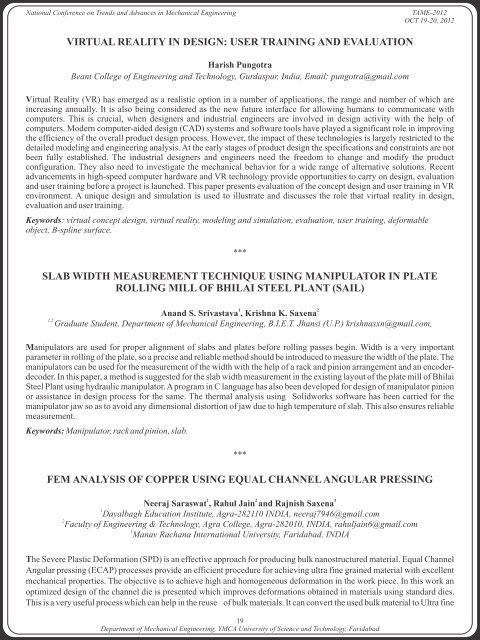Souvenir Containing Abstracts - YMCA University of Science ...
Souvenir Containing Abstracts - YMCA University of Science ...
Souvenir Containing Abstracts - YMCA University of Science ...
Create successful ePaper yourself
Turn your PDF publications into a flip-book with our unique Google optimized e-Paper software.
National Conference on Trends and Advances in Mechanical Engineering<br />
TAME-2012<br />
OCT 19-20, 2012<br />
VIRTUAL REALITY IN DESIGN: USER TRAINING AND EVALUATION<br />
Harish Pungotra<br />
Beant College <strong>of</strong> Engineering and Technology, Gurdaspur, India, Email: pungotra@gmail.com<br />
Virtual Reality (VR) has emerged as a realistic option in a number <strong>of</strong> applications, the range and number <strong>of</strong> which are<br />
increasing annually. It is also being considered as the new future interface for allowing humans to communicate with<br />
computers. This is crucial, when designers and industrial engineers are involved in design activity with the help <strong>of</strong><br />
computers. Modern computer-aided design (CAD) systems and s<strong>of</strong>tware tools have played a significant role in improving<br />
the efficiency <strong>of</strong> the overall product design process. However, the impact <strong>of</strong> these technologies is largely restricted to the<br />
detailed modeling and engineering analysis. At the early stages <strong>of</strong> product design the specifications and constraints are not<br />
been fully established. The industrial designers and engineers need the freedom to change and modify the product<br />
configuration. They also need to investigate the mechanical behavior for a wide range <strong>of</strong> alternative solutions. Recent<br />
advancements in high-speed computer hardware and VR technology provide opportunities to carry on design, evaluation<br />
and user training before a project is launched. This paper presents evaluation <strong>of</strong> the concept design and user training in VR<br />
environment. A unique design and simulation is used to illustrate and discusses the role that virtual reality in design,<br />
evaluation and user training.<br />
Keywords: virtual concept design, virtual reality, modeling and simulation, evaluation, user training, deformable<br />
object, B-spline surface.<br />
***<br />
SLAB WIDTH MEASUREMENT TECHNIQUE USING MANIPULATOR IN PLATE<br />
ROLLING MILL OF BHILAI STEEL PLANT (SAIL)<br />
1 2<br />
Anand S. Srivastava , Krishna K. Saxena<br />
1,2<br />
Graduate Student, Department <strong>of</strong> Mechanical Engineering, B.I.E.T. Jhansi (U.P.) krishnasxn@gmail.com,<br />
Manipulators are used for proper alignment <strong>of</strong> slabs and plates before rolling passes begin. Width is a very important<br />
parameter in rolling <strong>of</strong> the plate, so a precise and reliable method should be introduced to measure the width <strong>of</strong> the plate. The<br />
manipulators can be used for the measurement <strong>of</strong> the width with the help <strong>of</strong> a rack and pinion arrangement and an encoderdecoder.<br />
In this paper, a method is suggested for the slab width measurement in the existing layout <strong>of</strong> the plate mill <strong>of</strong> Bhilai<br />
Steel Plant using hydraulic manipulator. A program in C language has also been developed for design <strong>of</strong> manipulator pinion<br />
or assistance in design process for the same. The thermal analysis using Solidworks s<strong>of</strong>tware has been carried for the<br />
manipulator jaw so as to avoid any dimensional distortion <strong>of</strong> jaw due to high temperature <strong>of</strong> slab. This also ensures reliable<br />
measurement.<br />
Keywords: Manipulator, rack and pinion, slab.<br />
***<br />
FEM ANALYSIS OF COPPER USING EQUAL CHANNEL ANGULAR PRESSING<br />
1 2 3<br />
Neeraj Saraswat , Rahul Jain and Rajnish Saxena<br />
1<br />
Dayalbagh Education Institute, Agra-282110 INDIA, neeraj7946@gmail.com<br />
2<br />
Faculty <strong>of</strong> Engineering & Technology, Agra College, Agra-282010, INDIA, rahuljain6@gmail.com<br />
3<br />
Manav Rachana International <strong>University</strong>, Faridabad, INDIA<br />
The Severe Plastic Deformation (SPD) is an effective approach for producing bulk nanostructured material. Equal Channel<br />
Angular pressing (ECAP) processes provide an efficient procedure for achieving ultra fine grained material with excellent<br />
mechanical properties. The objective is to achieve high and homogeneous deformation in the work piece. In this work an<br />
optimized design <strong>of</strong> the channel die is presented which improves deformations obtained in materials using standard dies.<br />
This is a very useful process which can help in the reuse <strong>of</strong> bulk materials. It can convert the used bulk material to Ultra fine<br />
19<br />
Department <strong>of</strong> Mechanical Engineering, <strong>YMCA</strong> <strong>University</strong> <strong>of</strong> <strong>Science</strong> and Technology, Faridabad













